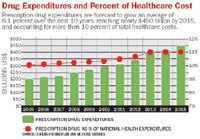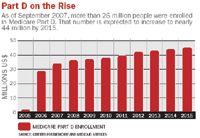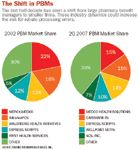Stop the Bleeding
Manufacturers overpay PBMs millions of dollars each year in rebates overpayments. Here's how to stop the leakage.
In today's competitive business environment, the pressure to reduce operational costs while simultaneously maximizing revenue and shareholder value is a challenge for executives in every industry. In the pharmaceutical industry, one area of significant loss—and opportunity—is managed care rebate programs.
The rise in participation in managed care programs in the US is staggering—from 40 percent in 1990, the rate has skyrocketed to 90 percent today. Much of this growth can be attributed to the government's use of managed care programs through Medicare Part D. In addition, since 1990, consistent fiscal pressures have increased the role of PBMs and other managed care organizations as principal negotiators with pharmaceutical manufacturers for complex rebate agreements.

Drug Expenditures and Percent of Healthcare Cost
Because pharmacy benefit managers (PBMs) oversee formulary development, managed care rebates have become the essential tool for pharmaceutical manufacturers to influence market share. Yet because most manufacturers don't have the necessary data on rebates, they lose billions of dollars each year in overpayments to trading partners.
Fortunately, manufacturers can adopt a series of "best practices" in this area, which will mitigate revenue leakage. By gaining access to granular, prescription-level sales data, manufacturers can identify the discrepancies that are responsible for rebate overpayments, address the issues with their trading partners, reclaim lost revenue, and, eventually, stop the bleeding.

Part D on the Rise
Flying Blind
Manufacturers enter into contractual relationships with PBMs, who in turn sell prescription medications to their constituents. Because patients pay different rates for a prescription based on their program's negotiated price, the actual price of the prescription isn't known until the drugs are distributed. This situation has resulted in a highly complicated rebate process in which PBMs submit invoices to manufacturers for rebate payments based on criteria such as sales volume or market share. These invoices typically include a summary of sales data representing what the PBM believes has been sold. Typically, the manufacturers review the summaries and pay the invoices.

The Shift in PBMs
This use of summarized data was sufficient when the volume of prescriptions paid through the rebate process was relatively low in comparison to the total number of prescriptions. But with more and more prescriptions being purchased via managed care plans, submission errors have increased exponentially—and most of those errors don't save money. Most manufacturers don't even realize that summarized sales data masks a variety of errors and discrepancies. For example, members often switch between prescription drug plans within a program. As a result, two PBMs might submit rebates for the same individual, charging the manufacturer twice for the same drugs. Another source of overpayment is mathematical mistakes, such as decimal point errors in units of measure, which can dramatically skew rebate claims.

A Proof of Value
Because pharmaceutical manufacturers only have access to high-level summaries from PBMs, they have no way of analyzing the underlying data to identify the source of errors. They are, in fact, flying blind. According to several internal audits, manufacturers overpay millions of dollars in rebates each year with no clear understanding of why, and no documentation to support potential disputes.
And it's a very big deal. Collectively, these discrepancies result in billions of dollars in lost revenue for the pharma industry. Based on today's prescription drug expenditures, an error rate of only 1 percent would result in industry-wide revenue leakage of more than $2 billion. And that's a conservative estimate when you take into account that the average error rate is more like 3 to 5 percent.
Handling Rebate Overpayments
Somewhat surprisingly, most manufacturers have not focused on claims validation and the clear opportunities it offers for revenue recovery. There are two main reasons: some have tried and failed, and others are simply not aware of the issue.
Many tier-one pharmaceutical manufacturers with annual gross revenue of more than $5 billion fall into the first category. They're aware of rebate overpayments, and have tried to build and implement their own internal systems to gather and analyze detailed sales data from trading partners. But there are many challenges in building complex, data-intensive information systems, and the results have been less than satisfactory.
Other manufacturers have hired vendors to gather and analyze the data externally. But in this "one-size-fits-all" solution, the vendors were unable to drill down to the manufacturers' individual trading partners and uncover specific errors and discrepancies. This is due to the fact that these vendors perform an identical, limited set of data validations for all PBM submissions. Manufacturers are, therefore, unable to alter validation parameters for particular PBMs or data submissions in order to target entity or data-specific error trends and known issues. As a result, they could only produce high-level reports that were not much better than what PBMs were offering.
Many tier-two and smaller pharmaceutical manufacturers, those with annual gross revenue below $5 billion, fall into the second category: they simply are not aware of rebate overpayment. They typically don't have the resources or infrastructure to identify such issues in the first place
The Storm Approaches
According to the Centers for Medicare and Medicaid Services' (CMS) National Health Care Expenditures Projections: 2005–2015, prescription drug costs will grow an average of 8.1 percent over the next 10 years. This indicates that at least $446 billion will be spent on prescription drugs in the year 2015(roughly double the expenditure in 2007.) Based on those projections, revenue leakage for manufacturers will skyrocket to almost $4.5 billion by the year 2015.
The advent of Medicare Part D has also thrown fuel on the fire. Perhaps the biggest script processing risk imposed by Medicare Part D is the potential massive switching of participants on a yearly basis between various Medicare Part D managed care plans. As of September 2007, more than 26 million individuals were enrolled in Medicare Part D, and this number is expected to grow to 43.8 million by 2015, further increasing the risk for error.
Another major issue stems from the fact that Medicare Part D is administered by commercial entities—the same entities that administer commercial drug plans. At its creation the government, looking for cost efficiencies and not wanting to create additional infrastructure, outsourced management of Part D to these companies because they already had the infrastructure in place to manage the programs.
But this consolidation has led to a host of rebate errors. The companies that manage Medicare Part D distribute prescription drugs under the various programs but with different price structures, and process the sales data through the same computer systems internally, often resulting in mispriced drugs, duplicate rebate submissions, and other discrepancies that are passed along to the pharmaceutical manufacturers. Add to this scenario the switching of participants between Medicare Part D and commercial plans, and you have a recipe for disaster.
Further roiling the managed care rebate atmosphere are significant changes taking place within the commercial PBM industry. For one thing, smaller PBMs are growing at the expense of larger ones. In 2002, the top three PBMs by prescriptions-per-year—held over half the total market share. By 2Q 2007, their share of the market had dropped to 44 percent. That same quarter, the top five PBMs' share dropped from 70 percent in 2002 to 61 percent.
These industry dynamics increase the risk for error in a variety of ways. Rapidly growing, smaller PBMs may have more immature processes and higher manual intensity, thereby increasing the risk of poor script quality and/or rebate processing errors. Mergers and divestitures among PBMs could also bring about organizational, process and automation/IT risks. All of these factors put increasing pressure on pharmaceutical manufacturers to incorporate a process through which they can validate claims and stem the flow of lost revenue.
How to Stop the Bleeding
The question for pharmaceutical executives is how best to guarantee results and maximize benefit. Based on 20 years of experience consulting with the world's leading pharmaceutical manufacturers, here are my best practices for claim validation and reducing rebate overpayment.
1. Bring It In-House Deploy an internal, integrated solution to automate claims validation; this offers a better return-on-investment than an external service. Once the initial acquisition and implementation costs have been realized, ongoing costs for an internal solution drop dramatically. You'll enjoy continual revenue recovery while remaining in full control of the process.
The other benefit of having the data in-house is that it enables you to perform a variety of advanced analyses to improve overall business processes. For example, manufacturers can use this data to make educated decisions about their contracting relationships.
2. Get Down to Details Manufacturers need a solution that enables them to examine and validate sales data down to the lowest granular level. You should be able to view the data by individual trading partner, submission time period, and each individual submission. That way, you can uncover and resolve specific discrepancies and errors. In addition, you can identify whether or not certain trading partners have tendencies toward particular issues with their data, and if so, improve your efficiency by targeting those specific issues moving forward.
3. Take Control Take control of your managed care rebates by designating someone within your contracts organization to be responsible for minimizing rebates and maximizing retained earnings. To be effective, this individual must have maximum control of how data is validated. This includes, on a granular scale, manufacturer- and product-specific elements, as well as the ability to vary validation strategies by individual trading partner and data submission.
4. Integrate with Internal Systems Directly integrate the claims validation solution with your internal contract and rebate payment systems in order to maintain the full integrity of the results. This provides rapid and accurate responses to data corrections within incoming utilization submissions, as well as within your own contract membership and product structures.
5. Capture and Track Data Implement systems that capture and retain all utilization data throughout the life cycle of the claims validation process. Ensure that you can access your prescription-level data at any time, and that you have a full audit trail to demonstrate how the data was validated. This will support trading partner reconciliation activities and help facilitate internal and external audits.
6. Conduct Validation Tests Clearly define your rebate validation process, ensuring it utilizes consistent and comprehensive validation tests. If you don't know whether or not you are operating in the most effective manner, take a snapshot of a few PBMs over a short period of time. This exercise will give a sense of what revenues could be regained through a claims validation strategy.
At this juncture, it's vital for manufacturers to recognize the inevitability of government examination within the context of Part D. As the next presidential election approaches, both opponents and proponents of the Medicare Part D legislation will look to more effectively quantify its results throughout the marketplace. Therefore, it's crucial that pharmaceutical manufacturers implement strategies within their commercial and Medicare Part D processes that provide the same level of detailed examination and transparency as is common practice within their internal Medicaid operations.
Now more than ever, market forces have converged that mandate that pharmaceutical manufacturers deploy a consistent and reliable strategy for utilization-based claim validation. Fortunately, this is one area that all but guarantees a solid return on investment along with numerous other benefits, both tangible and intangible, for those manufacturers that have the foresight to capitalize on the opportunity.
Chris Biddle is the vice president of Life Sciences Direction for I-many, Inc. He has consulted with leading pharmaceuticaturers to successfully validate rebate submissions, and currently consults for seven out of the 10 largest pharmaceutical manufacturers in the world. He can be reached at cbiddle@imany.com
The Misinformation Maze: Navigating Public Health in the Digital Age
March 11th 2025Jennifer Butler, chief commercial officer of Pleio, discusses misinformation's threat to public health, where patients are turning for trustworthy health information, the industry's pivot to peer-to-patient strategies to educate patients, and more.
Navigating Distrust: Pharma in the Age of Social Media
February 18th 2025Ian Baer, Founder and CEO of Sooth, discusses how the growing distrust in social media will impact industry marketing strategies and the relationships between pharmaceutical companies and the patients they aim to serve. He also explains dark social, how to combat misinformation, closing the trust gap, and more.

.png&w=3840&q=75)

.png&w=3840&q=75)



.png&w=3840&q=75)



.png&w=3840&q=75)























